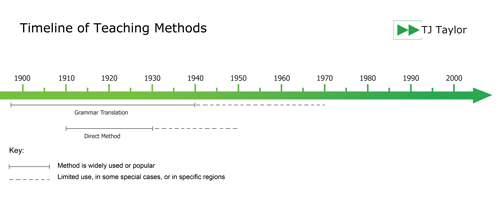Grammar Translation Method
Sometimes also known as the Classical Method, this is a traditional teaching technique that was used to teach Latin and Greek and was particularly in vogue during the 16th Century.
The focus at this time was on the translation of texts, grammar, and rote learning of vocabulary. There was no emphasis on speaking and listening comprehension because Latin and Greek were taught more as academic subjects rather than a means of oral communication.
This teaching method is still common in many countries and institutions around the world, and still appeals to those interested in languages from an intellectual or linguistic perspective. However, it does little to improve your ability to use the language for oral communication.

View large version with all methods
Direct Method
This approach, also known as the ‘oral‘ or ‘natural‘ method, originated around the 1900s as an alternative to the traditional grammatical translation method. At this time teachers were starting to experiment with teaching and educational models as previous techniques were failing to improve spoken communication.
The focus is on good pronunciation, with spontaneous use of the language, no translation, and little grammar analysis.
The Direct Method is based on the direct involvement of the student when speaking, and listening to, the foreign language in common everyday situations. Consequently, there is lots of oral interaction, spontaneous use of the language, no translation, and little if any analysis of grammar rules and syntax.
The focus of the lessons is on good pronunciation, often introducing learners to phonetic symbols before they see standard writing examples.
The Direct Method continues to provoke interest and enthusiasm today, but it is not an easy methodology to use in a classroom situation. It requires small classes and high student motivation, and in the artificial environment of a classroom it is difficult to generate natural situations of understanding and guarantee sufficient practice for everyone.
However, variants of this method have been developed where the teacher allows limited explanations in the student’s native language and explains some grammar rules to correct common errors a student may make when speaking.
One of the most famous supporters of this method was the German Maximilian Berlitz, who founded the Berlitz chain of private language schools.
Some characteristics of this method are:
- Lessons are in the target language
- There is a focus on everyday vocabulary
- Visual aids are used to teach vocabulary
- Particular attention is placed on the accuracy of pronunciation and grammar
- A systematic approach is developed for comprehension and oral expression
Summary
When – 1900 to 1930s approximately, some limited use into the 1970s
Focus – Everyday spoken language
Characteristics – Student learns by associating meaning directly in English
Supporters – Maximilian Berlitz, Carl Albert Krause
By Alex Taylor
